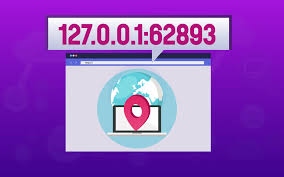Exploring the Significance and Applications of 127.0.0.1:62893
The address 127.0.0.1:62893 is an important concept in computer networking and software development. To understand its relevance fully, we must dive into the fundamentals of IP addressing, ports, and how they come together to form the basis for modern computing environments. This article provides a comprehensive overview of what 127.0.0.1:62893 represents, its practical applications, and troubleshooting tips for scenarios involving this configuration.
Breaking Down 127.0.0.1:62893
127.0.0.1: The Loopback Address
The IP address 127.0.0.1 is universally recognized as the loopback address. Its primary role is to allow a device to communicate with itself. The loopback interface provides a means for testing and troubleshooting without relying on external network hardware or connections.
- Purpose: The loopback address is mainly used for local development, self-diagnostics, and testing network functionality.
- Why 127.0.0.1?: The 127.0.0.0/8 range is reserved by the Internet Assigned Numbers Authority (IANA) for loopback purposes, but
127.0.0.1is the most commonly used address within this range. - Security Benefits: Loopback connections remain confined to the local machine, making them inherently secure from external attacks.
62893: Understanding Ports
In the context of 127.0.0.1:62893, the number 62893 refers to a port—a logical construct that allows applications to share a single IP address.
- What Are Ports?: Ports serve as communication endpoints for devices, enabling multiple services or applications to run simultaneously on a system.
- Port Ranges:
- Well-known ports (0-1023): Reserved for system-level or widely-used protocols (e.g., HTTP on port 80).
- Registered ports (1024-49151): Assigned for specific applications.
- Dynamic/ephemeral ports (49152-65535): Temporarily assigned by operating systems for short-term use, as is likely the case with port
62893.
When combined with 127.0.0.1, a port like 62893 becomes a gateway for locally hosted applications or services.
Common Use Cases of 127.0.0.1:62893
1. Local Development Environments
Developers frequently rely on 127.0.0.1 and various ports to host and test applications during development. For instance:
- A backend service running on Node.js might be hosted locally at
127.0.0.1:62893. - Python Flask applications often use
127.0.0.1with different ports to simulate web servers during coding and debugging.
By hosting applications locally, developers can ensure their code works as intended before deploying it to production environments.
2. Testing and Debugging Tools
The loopback address is integral to testing tools and debuggers. These tools often use ephemeral ports like 62893 to connect to applications and monitor their performance or functionality in real-time. Debugging in this manner is critical to:
- Detecting and fixing bugs.
- Analyzing application performance under simulated workloads.
- Ensuring system security by identifying vulnerabilities.
3. Database Access
Databases like MySQL or PostgreSQL can be configured to listen to the loopback address for local queries. For example:
- A developer could connect to a locally hosted database using
127.0.0.1:62893if the database is configured to use this port. This setup ensures secure and fast communication between the application and the database.
4. Local Servers
Web developers often use 127.0.0.1 to host servers for local testing. For instance:
- A temporary web server might run on
127.0.0.1:62893, accessible only from the local machine.
Technical Significance of Using 127.0.0.1
Using 127.0.0.1 over an external IP offers several advantages:
- No External Dependencies: Testing on
127.0.0.1does not require an active internet connection or network hardware. - Improved Security: Local-only communication reduces exposure to malicious actors.
- Minimal Latency: Communication happens within the same device, making it faster than external connections.
How to Troubleshoot Issues Related to 127.0.0.1:62893
While 127.0.0.1:62893 is relatively straightforward, issues can arise. Here are some common problems and their solutions:
1. Port Unavailability
If port 62893 is already in use by another process, the intended application cannot bind to it. To resolve this:
- Use a command like
netstatorlsof(Linux/macOS) to identify processes using the port. - Terminate the conflicting process or configure the application to use a different port.
2. Application Not Responding
If the application fails to respond at 127.0.0.1:62893:
- Verify the application is running and configured correctly.
- Check log files for errors or exceptions.
3. Firewall Blocking
Although rare for loopback traffic, some firewalls or security software may block access to specific ports. In such cases:
- Configure the firewall to allow traffic on
127.0.0.1:62893.
4. Service Misconfiguration
Ensure that the service or application is explicitly bound to 127.0.0.1 and not another address like 0.0.0.0, which would make it accessible to external networks.
Advanced Concepts
1. Virtual Machines and Containers
Tools like Docker and VirtualBox use loopback addresses extensively. For example, a containerized application might expose a port on 127.0.0.1:62893 for local debugging while being isolated from the host’s external network.
2. SSH Tunneling
Developers often use SSH tunnels to redirect traffic to local ports like 62893. For instance, an external server’s service might be securely accessed via an SSH tunnel ending at 127.0.0.1:62893.
Read also: ARK: Survival Evolved (2017) Game Icons Banners: Enhancing the Game’s Visual Identity
Conclusion
The address 127.0.0.1:62893 encapsulates the intersection of networking and application development. It demonstrates how loopback addresses and port configurations work together to facilitate secure, efficient, and isolated communication within a system. Understanding its role is crucial for developers, IT professionals, and network administrators to optimize workflows, troubleshoot effectively, and build robust software.
Whether hosting a local server, debugging an application, or testing a new feature, the power of 127.0.0.1:62893 lies in its simplicity and versatility. By mastering its use, you gain deeper insight into the foundational concepts of networking and computing.







